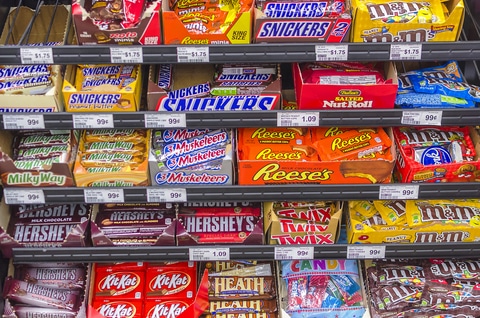
It happens to almost everyone. You go to the grocery store to pick up a few things for dinner, by the time you head out the door your bag is full of extra snacks and goodies. No doubt, America is a nation of impulse buyers. We make purchases on the spur of the moment to satisfy our cravings and to buy things we simply can’t resist. A recent study commissioned by Slickdeals, a deal-sharing website, made several observations about our buying habits.
- During their lifetime, adults will spend more than $324,000 on impulse buys
- On average, Americans spend$450 per month ($5,400 a year) on impulse items
- Americans typically make 156 impulse purchases a year, or 3 per week
HOW RETAILERS CAN CASH-IN
There’s nothing in the rulebook that says home improvement retailers can’t sell quick-turn impulse items such as snack foods, gadgets, and small gift items. It’s a smart idea since impulse purchases typically have a higher profit margin than other types of merchandise. Impulse items are one category brick-and-mortar stores can dominate because online hoppers tend to plan their purchases in advance and primarily focus on price and value. Don’t be afraid to think outside the box and sell impulse merchandise not typically sold in home improvement stores. It takes a little space and some ingenuity.
GRILLING FIRES UP SALES
Grilling has become an American pastime. Outdoor spaces are used year-round for relaxation, entertainment, and cooking family meals. Chefs featured on the Food Network have millions of devoted followers who faithfully watch and wait for grilling tips and time-saving ideas. It’s no wonder that grilling is hugely popular. According to the GMDC report, 63% of grillers make time to grill throughout the year, fueling 97 percent of total category sales growth.
SMARTPHONE ACCESSORIES
Has your phone ever powered down in the middle of a call? It’s not a good feeling. Low-cost electronic gadgets are practical gifts and are convenience items people purchase for themselves. There’s a reason why grocery stores and gas stations sell mini-power banks, earbuds, and keychain flashlights. More than 81 percent of all U.S. mobile phones are smartphones. With over 349 million users, the smartphone accessory industry is booming.
GIFT CARD MALLS
Carving out a niche to sell gift cards can be one of your more profitable use of space. Big box retailers such as Walmart and grocery chains offer customers a store-within-a-store experience by giving them an opportunity to purchase gift cards in one location. Selling gift cards is a turnkey operation that is profitable for the retailer, and extremely popular with consumers. According to Giftcards.com, the in-store gift card segment is a $91 billion industry within a category that generates more than $180 billion annually. Blackhawk Networks and InComm are the two companies primarily responsible for the management and distribution of gift card malls in the U.S. Both businesses take care of the entire process from start to finish.
SELL LOCAL PRODUCTS
Specialty products sourced locally are also good impulse items. Hand-made jewelry, greeting cards, and soaps are non-food products you may want to consider. Be resources and partner with a local business to build a mutually beneficial relationship.
Category Withstands economic-downturns
Unlike other industries, the economy has minimal impact on the pet category. Pet parents will continue feeding their pets and take them to the veterinarian even during the pandemic. Statistics indicate that 60 percent of cats and 56 percent of dogs in the U.S. are overweight. Sells of high-quality premium pet food continues to generate significant profits for retailers.
Good Profit Margins
Organic and gourmet pet foods can have profit margins as high as 40 percent. Popular chewing toys and bones are even higher at around 70 percent. Pet food accounts for 75 percent of all pet industry sales. Although the category is dominated by big companies such as Mars Petcare and Purina, smaller players like Blue Buffalo have a significant impact on consumers’ purchasing decisions.
Demand is Seasonless
Selling pet food, treats and accessories are always in season. There’s no need to limit cash flow several weeks a year or estimate future demand. Although the pet industry peaks in December around the holiday season, the demand is relatively steady throughout the year. This makes it easier to manage inventory and incorporate long-term planning.
New Products are Easy to Sell
Pet owners are eager to try new products that can benefit their beloved family members. Most new products introduced in the pet industry are self-explanatory and do not require a hard sell to close the deal. Owners actively engage in learning more about items that promote health, entertainment, and training. By the time most people visit a store, they have all of the information they need to make an informed purchase.
The Market Keeps Growing
The great news for retailers who sell pet products is the market keeps growing. Pet owners are buying both in physical stores and online. Ecommerce pet sales increased 51 percent in March 2020. By the end of the year, sales were estimated at $13.5 billion. The three reasons people give for shopping online are price, selection, and convenience. Retailers who operate physical stores and have an online presence will have even more opportunities to sell products and engage their customers.
The American Pet Products Association provides the following breakdown of the estimated $109 billion U.S pet industry for 2021.
- Pet Food & Treats: $44.1 billion
- Supplies, Live Animals & OTC Medicine: $23.4 billion
- Vet Care & Product Sales: $32.3 billion
- Other Services: $9.7 billion
New and Innovate Products
Traditionally, this category was limited to food, treats, beds, leashes, and grooming products. However, there are now more options due to innovations offered by entrepreneurs and emerging companies. According to Grand View Research, pet supplement sales will hit $1 billion by 2027. These include dog vitamins—catfish oil and probiotics—with CBD being the fastest-growing category. The spike in CBD sales most likely has to do with early research that shows the oil may help treat canine osteoarthritis, a condition that afflicts 20 percent of dogs more than a year old. Other products include pet wipes, cat toothpaste, and battery-operated, wi-fi-connected litterboxes.
Retailers who are not currently selling pet products but plan to get into the business should start small and identify the best products to sell in their particular market. Offer shoppers products that are not typically found at the grocery store or big-box retailers. Remember, owners, love their pets and are willing to spend more on quality products. Please do your research and conduct a brief survey to ask customers about the products they currently purchase. In the case of the pet category, it pays to be different from your competitors.




